Tuc d'Audoubert
The complex system of subterranean passages at Montesquieu-Avantès in the foothills of the central French Pyrenees through which the River Volp flows is conventionally divided into three caves, Le Tuc d'Audoubert to the west, Les Trois-Frères in the centre and Enlène to the east.
While the eastern two are connected by a narrow corridor, no usable passage connects Tuc d'Audoubert with Trois-Frères and the only current means of access is by boat. At Tuc d'Audoubert the galleries lie on three levels, the lowest carrying the River Volp, the 'median' with decorated galleries (La Salle Nuptiale, La Galerie des Gravures) and the upper with further decoration (La Chatière, Salle des Talons) terminating in the Salle des Bisons containing the celebrated modelled clay bison.
The position of Trois-Frères and Enlène approximates to the upper level of Tuc d'Audoubert. Trois-Frères has numerous galleries with several possible original entrances, although the only certain Magdalenian access was through Enlène. Whereas Trois-Frères contains one of the most prolific arrays of wall art (Galerie des Mains, Chapelle de la Lionne, Galerie des Points, Salle du Grand-Eboulis, Sanctuaire, Galerie des Chouettes, Galerie de l'Hémione), Enlène has none. However excavations at Enlène have revealed a considerable range of engraved bones and stone plaquettes from occupation deposits.
Bégouën et al. (1991)
The cave of Tuc Audoubert was discovered by the three sons of Count Henri three Bégouën on 20 July and 10 October 1912, and the Three Brothers July 21, 1914. These findings are not due to chance, but are linked to the supportive family environment of the discoverers. In 1911, Henri Bégouën organised a trip to the Mas d'Azil with his children, Max, Jacques and Louis, aged 18, 16 and 15 years. There, they dug in the old spoil from previous excavations and Max discovered a fragment of a Magdalenian perforated reindeer tooth. Excited, on their return they visited the nearby Enlène cave where Jacques has the incredible luck to find a beautiful wooden reindeer spear thrower! This finding triggered in them the desire to learn more about these ancient civilisations whose cultural wealth was thus revealed to them.
During the summer holidays of 1912, July 20, they decided to explore the resurgence of Volp using a raft they made, and thus discovered the cave of Tuc d'Audoubert and the first engravings. A prehistorian, Emile Cartailhac, a family friend, was called immediately and authenticated the drawings. On 10 October, through a narrow gap which became known as the catflap, with the help of their friend François Camel, they penetrated the upper galleries at the bottom of which awaited the clay bisons!

Plan of the cave system.
Photo: Bégouën et al. (2014)
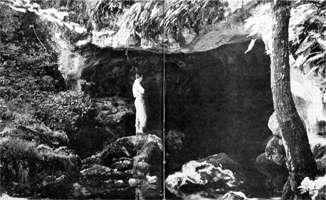
The rive Volp leaving the limestone cavern of Tuc d'Audoubert at Montesquieu-Avantès in the Province of Ariège, France.
Photo:
Breuil (1979)
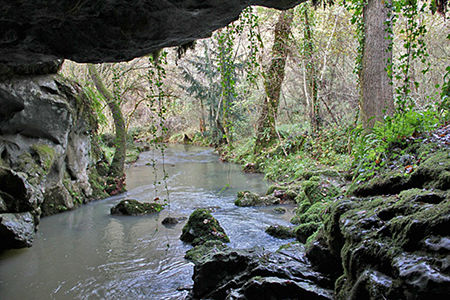
Another view of the rive Volp leaving Tuc d'Audoubert, looking out from just inside the cave mouth.
Photo: © Michel31
Source: http://mototracteurs.forumactif.com/t25620-les-couleurs-de-l-automne
The cave of le Tuc d'Audoubert was the first discovered by the three sons of Comte Bégouën and their companion François Camel on the 20th July and the 10th October 1912, while the cave of les Trois Frères was discovered two years later, on July 20, 1914.
Upon discovery, these caves had several factors in favour of their study and conservation, not least the family of their discoverers. Émile Cartailhac, holder of the Chair of Prehistoric Archaeology of Toulouse, was asked for his advice very early in the piece. His advice was listened to, especially that, of the decorated caves recognised at the beginning of the twentieth century, some were already exploited and damaged, especially in the Pyrenees. A philosophy of conservation was then developed, not only imposed by the quality and quantity of the excavated remains, but also by the feeling of their terrible fragility.
Thus no opening to the public was ever considered, visits were reserved only to prehistorians, with facilities reduced to the minimum necessary, the footprints on the floors marked the immediate establishment of a trail from which it was (and still is) forbidden to depart, and the vast majority of the flints and bones left by the Magdalenians were left in situ.
In 1992 the decision was made to restart research at le Tuc d'Audoubert, shortly after a search of l'Enlène, the third of the group of closely associated caverns, which had brought together, for fifteen years, thirty young researchers at Pujol. With some of them, Robert Bégouën got together a team. The original idea was to publish only new discoveries, particularly the engravings of the Salle du Cheval Rouge and those of the diverticules of the Siphon and the Claviformes, most of which had been identified in 1964 and 1965 during two missions under the direction of Henri Lhote. But we realised very quickly that the requirements with respect to the recording of parietal art had greatly evolved, and that these long-standing records were no longer usable! It was necessary to start work from the beginning. The research was completed in the cave in 2004, and the publication of a complete monograph was expected in late 2007. Text above: Bégouën et al. (2007)
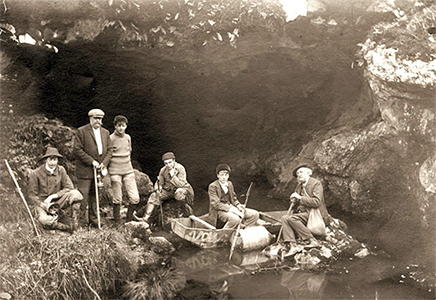
The entrance to the cave at the time of discovery. The young discoverers in the company of their father, the Abbé Breuil, and Emile Cartailhac (doc. Assoc. L. Bégouën).
Photo and text: http://www.creap.fr/imagesCREAPweb/imgsTuc/Tuc-fig01.htm
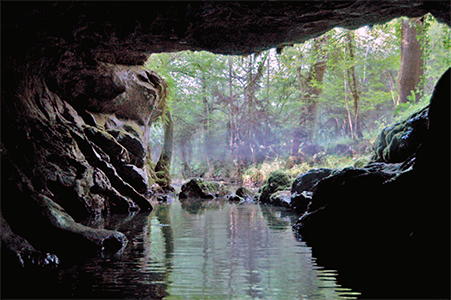
The entrance to la grotte du Tuc d'Audoubert, seen from the interior of the cave at the exit of the Volp River.
Photo and text: Bégouën et al. (2007)
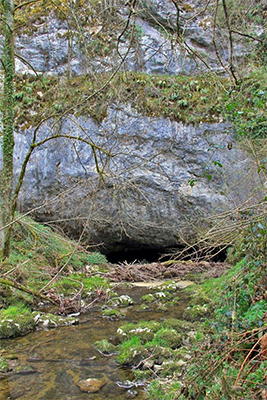
Exit of the Volp River, in springtime.
Photo: © Michel31
Source: http://mototracteurs.forumactif.com/t27960-le-printemps-est-revenu
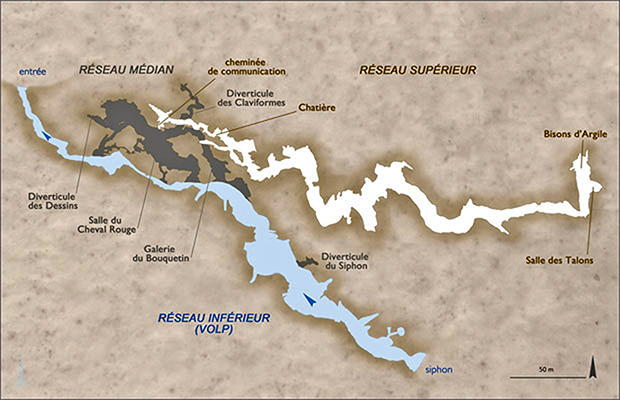
Map of the cave. It is on three levels, the lowest being at the level of the Volp River, then the middle chambers, then the upper network which contains the clay bisons sculpture.
Photo: http://www.creap.fr/imagesCREAPweb/imgsTuc/Tuc-fig02.htm
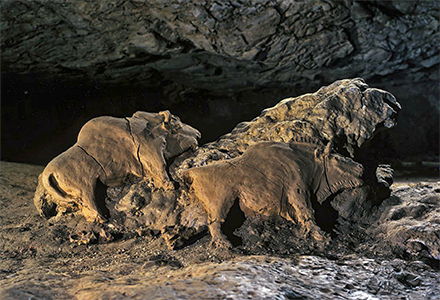
The bisons from Tuc d'Audoubert, a cave which was discovered in 1912. These figures are modelled in clay and rest on a rock in the Salle Terminale, Réseau Supérieur of le Tuc d'Audoubert. The female bison is 62 cm long.
Photo: Bégouën et al. (2014)
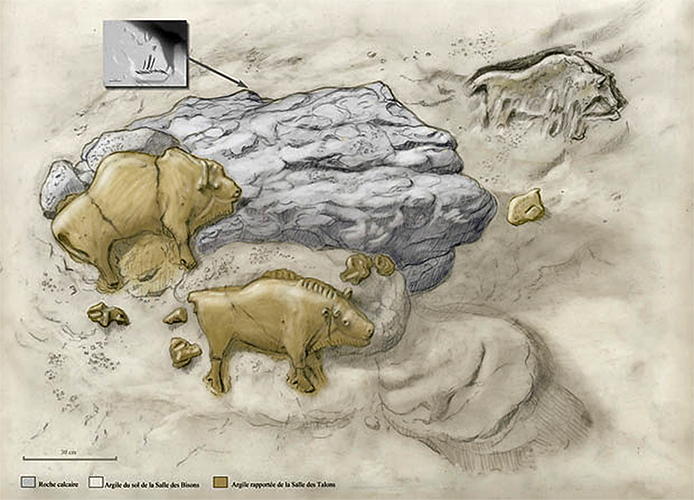
The clay bisons and their nearby environment.
Grey - limestone rock
Light tan - clay from la Salle des Bisons
Dark tan - clay from la Salle des Talons
Photo: doc. G. Tosello - Assoc. L. Bégouën
Source and text: http://www.creap.fr/imagesCREAPweb/imgsTuc/Tuc-fig11.htm
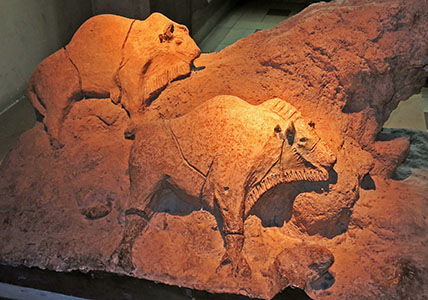
The clay bisons from Tuc d'Audoubert.
Photo: Don Hitchcock 2014
Source: Facsimile, Musée d'Archeologie Nationale et Domaine, St-Germain-en-Laye
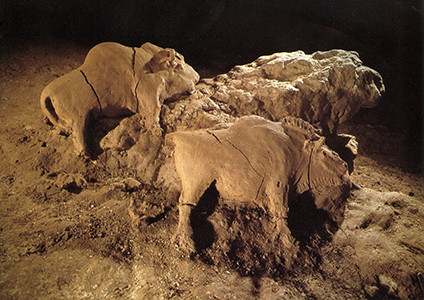
The clay bisons from Tuc d'Audoubert.
Photo: Original, J. Vertut, collection Bégouën
Source: Leroi-Gourhan (1984)
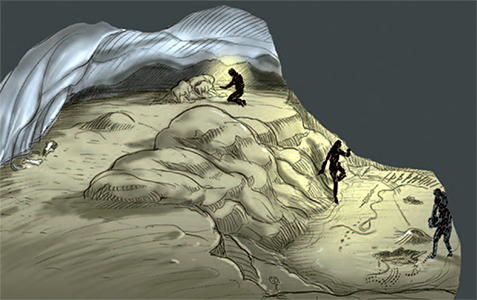
Drawing showing the close relationship established by the sculptors between the Salle des Talons, source of the clay material, and the Salle des Bisons, the display area for the creation of the sculptures.
Réseau Supérieur of le Tuc d'Audoubert.
Photo and text: Bégouën et al. (2007)
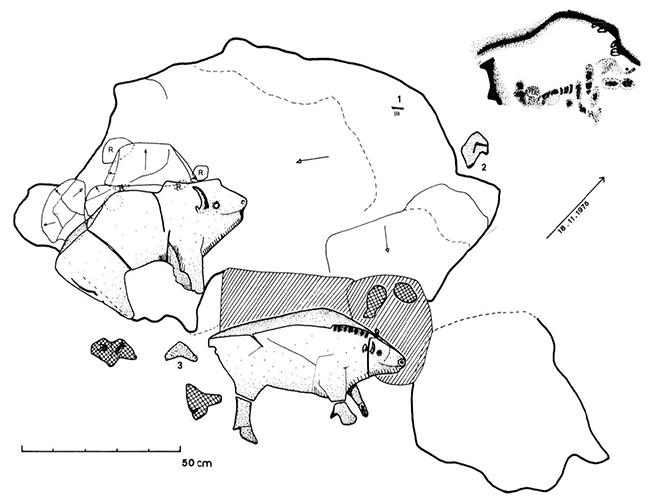
The clay bisons of Tuc d'Audoubert.
1 Fine engraving on the rock
2 The small bison
3 Detached tail of the first bison.
On the rocks, arrows indicate the direction of the slope. Kneaded clay is represented by a grid, clay lumps are shown by shading.
Drawing R. Bégouën and J. Clottes
Photo and text: Bégouën et al. (1977)
The story of the little bison
The cave was discovered at Tuc d'Audoubert on Tuesday 12th July 1912 in circumstances that we know. Clay bison were found, after work to unblock the cave, on October 10th, 1912 by the three brothers Max, Louis and Jacques Bégouën and their friend François Camel. But it was not until Sunday, October 20, 1912, during the visit that made Breuil and E. Cartailhac, that the latter, being on all fours around the bison and the rock which supports them, put his hand accidentally on an object that seemed unusual to him, lifted it, and thus found the small bison.
It is clear that the circumstances of this unexpected find will always prevent us from knowing the exact position of the original small bison. It is also possible that it suffered somewhat during the discovery.
At that time, the cave was obviously not closed, and the discoverers were concerned that unwanted visitors would roam the cave and steal or destroy this small bison, comparable to movable art and a very vulnerable object. They therefore brought it back the same evening to the home of Count Bégouën. The input is communal, so it was assumed that the cave belonged to the town of Montesquieu-Avantès, of which Comte Bégouën was mayor.
Two dangers threatened: on one part numerous visitors, or development works for them. A few tens of kilometres away, Niaux cave had long been a fashionable venue for cave visits. Secondly, the greed of treasure seekers.
Indeed, following the discovery of a propulseur in the nearby Grotte d'Enlène, the owner, M. de Méritons, could not imagine that this treasure was purely scientific, and had believed in the discovery of a real monetary treasure, and had prohibited access to his cave to anyone, including the Bégouën family, which caused quite a stir in the country and confirmed stubborn legends that attributed to the caves buried treasures like the ruins of feudal castles.
To ensure the protection of the Cave of Tuc d'Audoubert, even before the discovery of clay bison, the cave was leased to E. Cartailhac, as Delegate of the Ministry of Education for Historic Monuments. After the discovery, it was necessary to persuade the inhabitants of the town at the same time that the cave was of value to science, and that the interests of the municipality would be in no way harmed. Count Bégouën's position, a distinguished prehistorian , but at the same time Mayor of the town, was not very comfortable.
The little clay bison therefore was put before the City Council to see, as an illustration of the type of discoveries that can be made in caves. Salomon Reinach, Curator of the Museum of National Antiquities in Saint-Germain-en-Laye, offered 100 gold francs to purchase it, to the great amazement of councillors, some of whom exclaimed "He must be very learned to attach so much value to a piece of shit (sic)".
The small bison rejoined the collection of the Musée des Antiquités Nationales under No. 58.030; it is still there, in perfect condition.
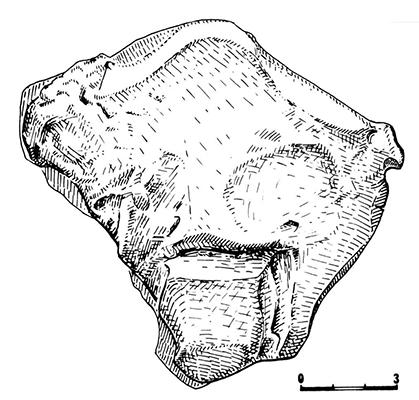

The little Bison.
Drawing by G. Nicolardot (ERA no 423 du C.N.R.S.).
Photo by Chéret (M.A.N.)
Source and text: Bégouën et al. (1977)
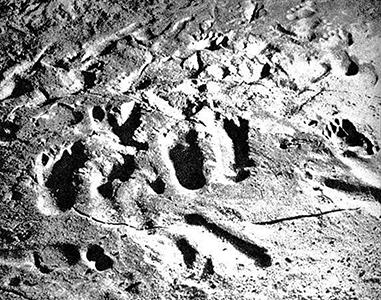
Footprints in the clay near the bison. John Robinson describes the scene:
'We turned to the sunken cave floor behind us. We slid down to it and stood beside a flat clay floor. A few footprints of adults can be seen in the clay, but mainly the footprints are of young children. Towards the rear wall of the cave, cut out of the floor, is a hole in the four inch thick clay where a slab has been removed, the shape and size of one of the Bison. Surely this was where the clay used to model the Bison had come from.'
Photo and text: John Robinson, http://www.bradshawfoundation.com/france/bison-tuc-d-audoubert/bison-tuc-d-audoubert2.php
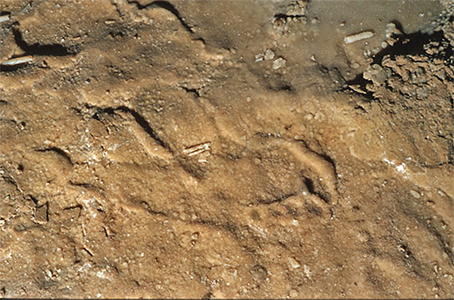
Réseau Supérieur: footprint in the clay.
Plaster casts have never been made of these footprints. In order to do so, the soil must first be hardened with chemicals, so that the prints are not as they were originally.
These prints are just as they were 17 000 years ago.
Photo: Assoc. L. Bégouën doc
Source and text: http://www.creap.fr/imagesCREAPweb/imgsTuc/Tuc-fig09.htm
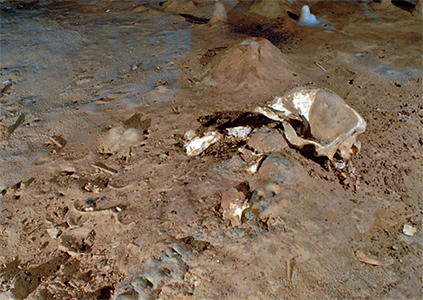
Cave bear skull, broken, surrounded by footprints on the clay soil of the Gallery of Footprints, Réseau Supérieur of le Tuc d'Audoubert.
Photo and text: Bégouën et al. (2007)
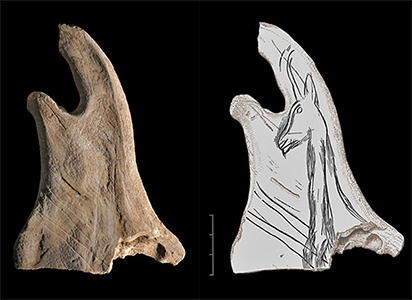
Chamois engraved on a fragment of the mandible of a bison, Tuc d'Audoubert.
Photo: Assoc. L. Bégouën doc
Source and text: http://www.creap.fr/imagesCREAPweb/imgsTuc/Tuc-fig05.htm

Detail of a series of claviformes, club-shaped signs, engraved on the ceiling of a small gallery (height of a sign 25 cm). Diverticule des Claviformes, Réseau Médian of the Tuc d'Audoubert.
Photo and text: Bégouën et al. (2007)
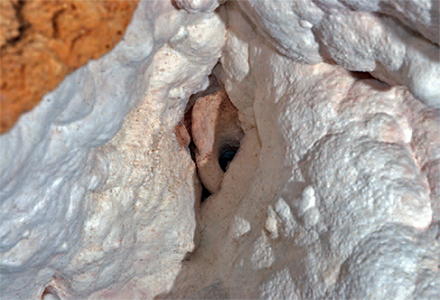
Fragment of the diaphysis (the main midsection or shaft of a long bone) of what is probably a bison, stuck deep in a crack and partially covered with white calcite. The width of the bone is 8 cm.
Galerie du Bouquetin, Réseau Médian of the Tuc d'Audoubert.
Photo and text: Bégouën et al. (2007)
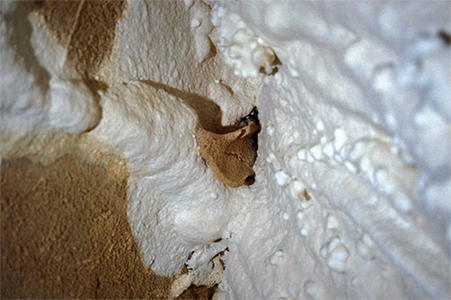
Bone fragment stuck in a crack in the wall.
Photo: doc. Assoc. L. Bégouën, http://www.creap.fr/imagesCREAPweb/imgsTuc/Tuc-fig03.htm
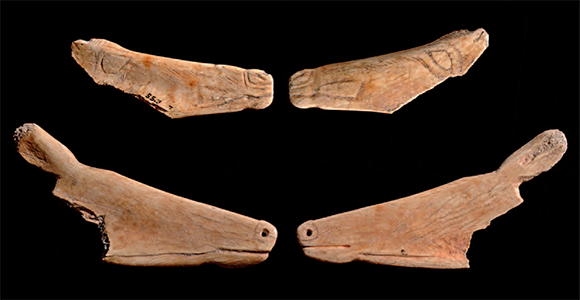
Heads of a horse (top) and deer (bottom) carved from the hyoid bone of a horse. Middle Magdalenian. Each side is shown.
Lengths 6 and 8 cm.
Galerie de Bouquetin, Réseau médian of le Tuc d'Audoubert.
Collection du musée de l'Homme, Paris
Photo and text: Bégouën et al. (2007)

Heads of a horse (top) and deer (bottom) carved from the hyoid bone of a horse. Middle Magdalenian.
A slightly better quality image than the one above, but showing just one side.
Lengths 6 and 8 cm.
Galerie de Bouquetin, Réseau médian of le Tuc d'Audoubert.
Photo: doc. Assoc. L. Bégouën, http://www.creap.fr/imagesCREAPweb/imgsTuc/Tuc-fig04.htm
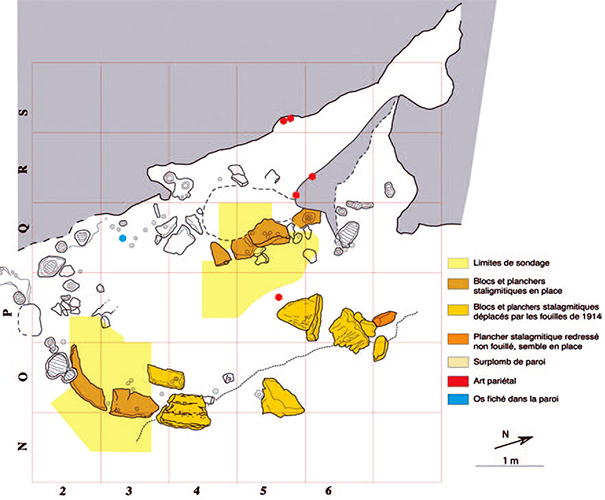
Plan of a structure formed by blocks of concretions and stalagmitic floor plates set on edge, delimiting an area of 18 m2 under a low ceiling. Middle Magdalenian, Réseau Médian du Tuc d'Audoubert
Photo and text: Bégouën et al. (2007)
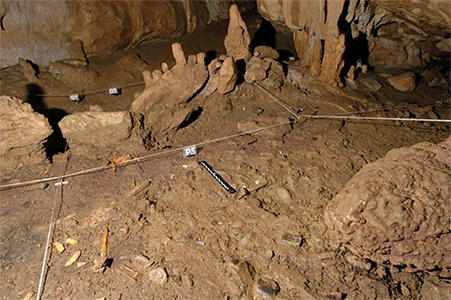
Photograph of the walls of blocks set on edge under a low ceiling, during their excavation.
Réseau médian of le Tuc d'Audoubert.
Photo: doc. Assoc. L. Bégouën, http://www.creap.fr/imagesCREAPweb/imgsTuc/Tuc-fig06.htm
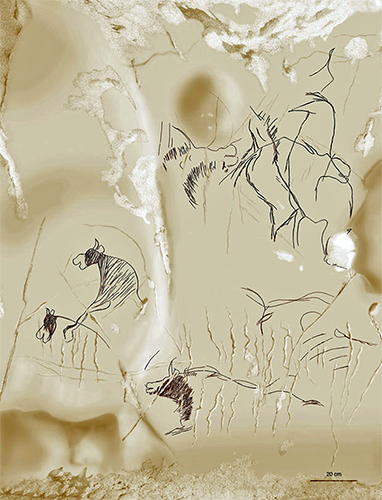
Panel of the monsters, engraved on the wall in front of the chatière.
Réseau Supérieur of le Tuc d'Audoubert.
Photo: doc. Assoc. L. Bégouën, http://www.creap.fr/imagesCREAPweb/imgsTuc/Tuc-fig08.htm
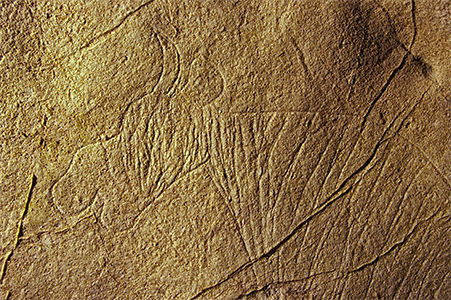
A 'monster' from Tuc d'Audoubert.
Photo: Bégouën et al. (2014)

Reindeer bones, kitchen waste from a human meal in the cave, carrying marks of a wolf or fox.
These marks show that carnivores, coming to the camp after the departure of the people, had entered the cave via the bed of the Volp, which was then at a low level.
Photo: doc. Assoc. L. Bégouën, http://www.creap.fr/imagesCREAPweb/imgsTuc/Tuc-fig12.htm
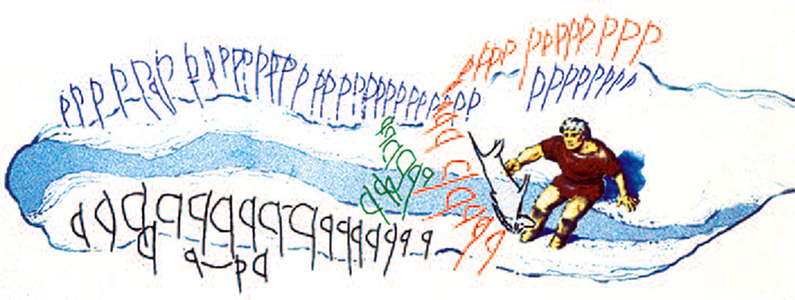
Schematic view of the four series of claviform signs, and the engraved horse, on the ceiling and walls of the the Diverticule des Claviformes.
Photo and text: Bégouën et al. (2007)
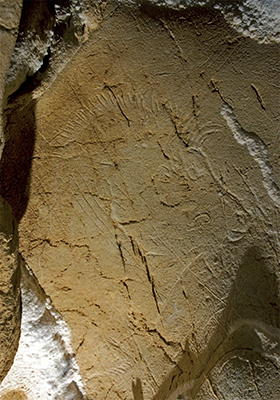
Large bison engraved on the wall, height 53 cm.
Diverticule des Dessins, Réseau Médian of le Tuc d'Audoubert.
Photo and text: Bégouën et al. (2007)
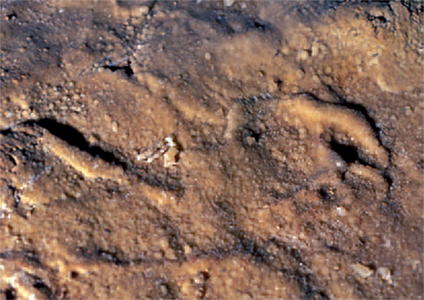
Imprint of the right foot on the clayey soil and since covered with calcite.
Galerie des Empreintes, Réseau Supérieur of le Tuc d'Audoubert.
Photo and text: Bégouën et al. (2007)
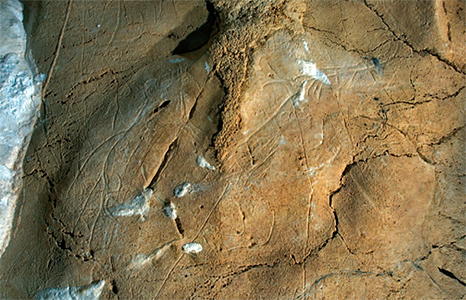
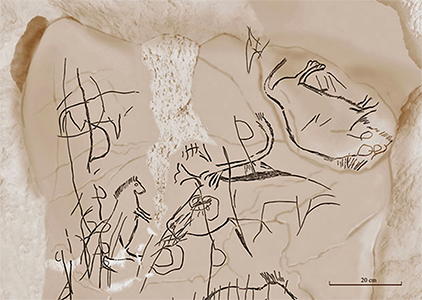
Horse, reindeer and claviform signs engraved on the wall. Height of horse 32 cm.
Above the reindeer, on the right, an inverted bison.
Diverticule des Dessins, Réseau Médian of le Tuc d'Audoubert.
Photo (left) and text: Bégouën et al. (2007)
Photo (right): doc. Assoc. L. Bégouën, http://www.creap.fr/imagesCREAPweb/imgsTuc/Tuc-fig07.htm
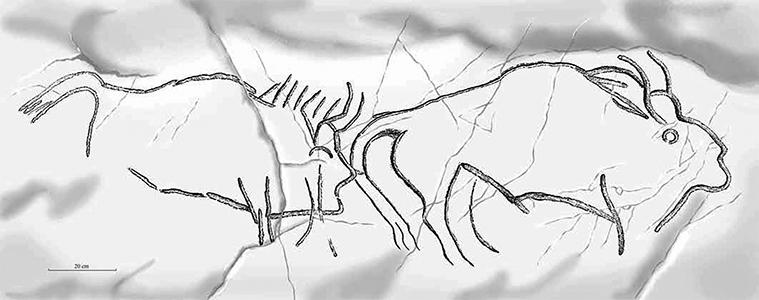
Drawing of two large bison drawn with the finger tips under a low ceiling.
Length of male 109 cm.
Diverticule du Siphon, Réseau Médian of le Tuc d'Audoubert.
Photo and text: Bégouën et al. (2007)
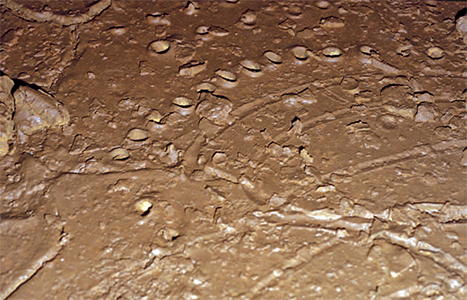
Composition of points and lines drawn by the fingers on the yellow clay of the floor. The drawings are covered by a fine film of brown sediment and small limestone fragments fallen from the ceiling.
Right side of the Salle des Talons, Réseau Supérieur of le Tuc d'Audoubert.
Photo and text: Bégouën et al. (2007)
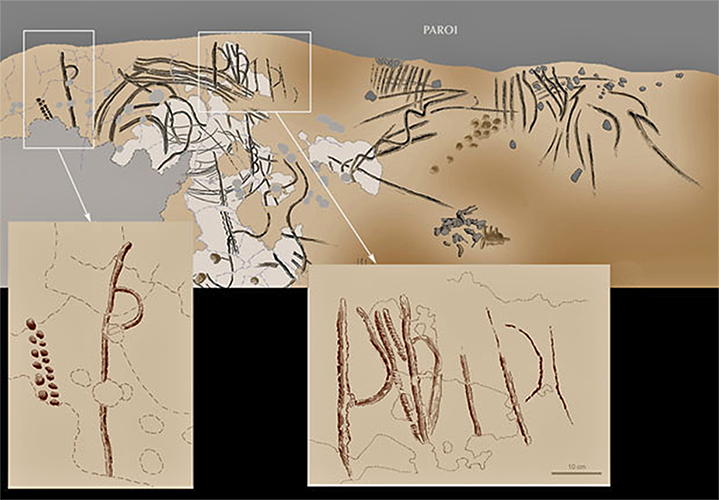
Réseau Supérieur: Claviform signs and other graphic designs made with finger tips in the clay floor of la Salle des Talons.
Photo: doc. Assoc. L. Bégouën, http://www.creap.fr/imagesCREAPweb/imgsTuc/Tuc-fig10.htm
References
- Bégouën H., 1920: Un dessin relevé dans la caverne des Trois-frères, à Montesquieu-Avantès (Ariège), Comptes rendus des séances de l'Académie des Inscriptions et Belles-Lettres, 64e année, N. 4, 1920. pp. 303-310.
- Bégouën H., 1929: À propos de l'idée de fécondité dans l'iconographie préhistorique, Bulletin de la Société préhistorique française, 26, 3, pp 197-199.
- Bégouën L., 1939: Pierres gravées et peintes de lépoque magdalénienne, Mélanges Bégouën, pp. 289-305
- Bégouën H., Breuil H., 1958: Les cavernes du Volp , Paris, Ed. Arts et métiers graphiques, p. 10, 48, 77, 89.
- Bégouën R., Clottes J., Delporte H., 1977: Le retour du petit bison au Tuc d'Audoubert, Bulletin de la Société préhistorique française , Comptes rendus des séances mensuelles. 1977, tome 74, N. 4. pp. 112-120
- Bégouën R., 1984: Projet d'étude globale les cavernes du Volp, http://www.cavernesduvolp.com/Begouen_1984.pdf
- Bégouën R., Clottes J., 1991: Portable and Wall Art in the Volp Caves, Montesquieu-Avantès (Ariège), Proceedings of the Prehistoric Society, , 57, pp 65-79.
- Bégouën R., Fritz C., Tosello G., Clottes J., Faist F., Pastoors A., Lacombe S., Fosse P., 2007: Les Magdaléniens modelaient aussi l'argileLes Dossiers d'Archéologie, No. 324, November/December 2007
- Bégouën R., Clottes J., 2008: Douze nouvelles plaquettes gravées d'Enlène, Espacio, Tiempo y Forma, Serie I, Nueva época. Prehistoria y Arqueología, t. 1, 2008. pp. 77-92
- Bégouën E., Bégouën M., 2013a: Découverte d'un grand phallus gravé magdalénien dans la grotte des Trois-Frères (Ariège), Bulletin de la Société Préhistorique Française , Tome 110, numéro 1, janvier-mars 2013, p. 127-129.
- Bégouën E., Bégouën M., 2013b: New discoveries in the Sanctuary of Les Trois-Frères cave (Ariège), Quartär , 60 (2013): 107-114
- Bégouën R., Clottes J., Feruglio V., Pastoors A., 2014: La caverne des Trois-Frères, Co-edition Louis Association Bégouën / Somogy Editions d'Art, 248 pp, 288 ill.
- Breuil H., 1930: Un dessin de la grotte des Trois frères (Montesquieu-Avantès) Ariège, Comptes rendus des séances de l'Académie des Inscriptions et Belles-Lettres, 74e année, N. 3, 1930. pp. 261-264.
- Breuil, H., 1979: Beyond the Bounds of History, Scenes from the Old Stone Age, Gawthorn, 1979, reprinted from the edition of 1949, London.
- Broglio A., 1998: Introduzione al Paleolitico, Laterza, Bari 1998: 2006(6): p. 254;
- Giraud J., Rouzaud F., Bégouën R., Clottes J., 1982: Plaquette gravée d'Enlène, Montesquieu-Avantès (Ariège)Bulletin de la Société préhistorique française 1982, tome 79, N. 4. pp. 103-109.
- Guthrie, R.D., 2005: The nature of Paleolithic art Published by University of Chicago Press, 2005 ISBN 0226311260, 9780226311265 507 pages
- Leroi-Gourhan A., 1984: L'Art des cavernes : Atlas des grottes ornées paléolithiques françaises, Relié – 1 décembre 1984
- Sieveking, A., 1979: Cave Artists (Ancient Peoples and Places)
Back to Don's Maps
 Back to Archaeological Sites
Back to Archaeological Sites